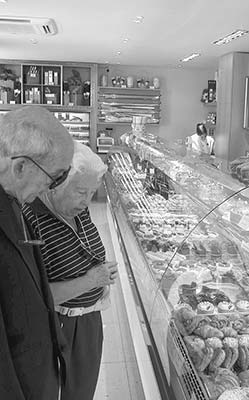
DEPARTMENT STORES (LES GRANDS MAGASINS)
Place de la Madeleine to Place de l’Opéra
Map: Place de la Madeleine Shopping Walk
Sèvres-Babylone to St. Sulpice
Map: Sèvres-Babylone to St. Sulpice Walk
Map: Puces St. Ouen Flea Market
Traffic-Free Shopping and Café Streets
ARCADED SHOPPING STREETS (PASSAGES)
Shopping in chic Paris is altogether tempting—even reluctant shoppers can find good reasons to indulge. Wandering among elegant boutiques provides a break from the heavy halls of the Louvre, and, if you approach it right, a little cultural enlightenment.
If you need just souvenirs, visit a souvenir shop. A neighborhood supermarket is a good place to find that Parisian box of tea, jam, or cookies—perfect for tucking into your suitcase at the last minute. For more elaborate purchases, large department stores provide painless one-stop shopping in classy surroundings. Neighborhood boutiques offer the greatest reward at the highest risk. Clerks and prices can be intimidating, but the selection is more original and the experience is purely Parisian. Just be sure you don’t leave your shopping for Sunday, when most stores are buttoned up tight.
Even if you don’t intend to buy anything, budget some time for window shopping, or, as the French call it, faire du lèche-vitrines (“window licking”).
Before you enter a Parisian store, remember the following points:
• In small stores, always say, “Bonjour, Madame or Mademoiselle or Monsieur” when entering. And remember to say “Au revoir, Madame or Mademoiselle or Monsieur” when leaving.
• The customer is not always right. In fact, figure the clerk is doing you a favor by waiting on you.
• Except in department stores, it’s not normal for the customer to handle clothing. Ask first before you pick up an item: “Je peux?” (zhuh puh), meaning, “Can I?”
• By law the price of items in a window display must be visible, often written on a slip of paper set on the floor or framed on the wall. This gives you an idea of how expensive or affordable the shop is before venturing inside.
• For clothing size comparisons between the US and France, see here of the appendix.
• Forget returns (and don’t count on exchanges).
• Observe French shoppers. Then imitate.
• Saturday afternoons are très busy and not for the faint of heart.
• Stores are generally closed on Sunday. Exceptions include the Galeries Lafayette store near the Opéra Garnier, the Carrousel du Louvre (underground shopping mall at the Louvre with a Printemps department store), and some shops near Sèvres-Babylone, along the Champs-Elysées, and in the Marais.
• Some small stores don’t open until 14:00 on Mondays.
• Don’t feel obliged to buy. If a shopkeeper offers assistance, just say, “Je regarde, merci.”
• For information on VAT refunds and customs regulations, see here.
Avoid souvenir carts in front of famous monuments and, instead, look for souvenir shops. You can find cheaper gifts around the Pompidou Center, on the streets of Montmartre, and in some department stores (see next). The riverfront stalls near Notre-Dame sell a variety of used books, old posters and postcards, magazines, refrigerator magnets, and other tourist paraphernalia in the most romantic setting; see here in the Historic Paris Walk chapter. You’ll find better deals at the souvenir shops that line Rue d’Arcole between Notre-Dame and Hôtel de Ville and on Rue de Rivoli, across from the Louvre.
Like cafés, department stores were invented here (surprisingly, not in America). These popular stores are often crowded (every day here feels like Black Friday) and may seem overwhelming at first, but the ones listed here are accustomed to wide-eyed foreign shoppers and have English-speaking staff. These stores are not just beautiful monuments; they also offer insights into how Parisians live. It’s instructive to see what’s in style, check out Parisians’ current taste in clothes and furniture, and compare the selection with stores back home.
Parisian department stores begin with their showy perfume sections, almost always central on the ground floor, and worth a visit to see how much space is devoted to pricey, smelly water. Helpful information desks are usually located at the main entrances near the perfume section (with floor plans in English). Stores generally have affordable restaurants (some with view terraces) and a good selection of fairly priced souvenirs and toys. Opening hours are customarily Monday through Saturday from 10:00 to 19:00. Some are open later on Thursdays, and all are jammed on Saturdays and closed on Sundays (except in December). The Galeries Lafayette main store and the Printemps (pran-tahn) store in the Carrousel du Louvre are exceptions—they’re open daily, including Sundays.
You’ll find both Galeries Lafayette and Printemps stores in several neighborhoods. The most convenient and most elegant sit side by side behind the Opéra Garnier, complementing that monument’s similar, classy ambience (Mo: Chaussée d’Antin-La Fayette, Havre-Caumartin, or Opéra, see map on here). Both stores sprawl over multiple buildings and consume entire city blocks. The selection is huge, crowds can be huger (especially on summer Saturdays), and the prices are considered a tad high.
Galeries Lafayette is a must-see for its colorful ceiling, trad-chic ambience, and city views from the rooftop. To reach the store, circle around the right side of the Opéra Garnier to the main building (of three) located right at the Chaussée d’Antin Métro stop, at 40 Boulevard Haussmann. Enter and work your way to the heart of the store, where you can gaze up at the store’s main attraction: a sensational, stained-glass belle époque dome hovering 150 feet overhead. Ride the escalator up. The first three floors up have bars or cafés with great views of the dome above and the shopping action below. (The Starbucks on the third floor has amazing view seats.) The fifth floor has unique children’s toys, and the sixth floor has Paris souvenirs and a good-value cafeteria with views. Finally, ascend to the seventh floor (la terrasse) for a grand, open-air rooftop view of tout Paris, starring the well-put-together backside of the Opéra Garnier. Two nice bars offer drinks and light plates with dramatic seating. Fashion shows are open to the public once a week through the season (details at www.galerieslafayette.com).
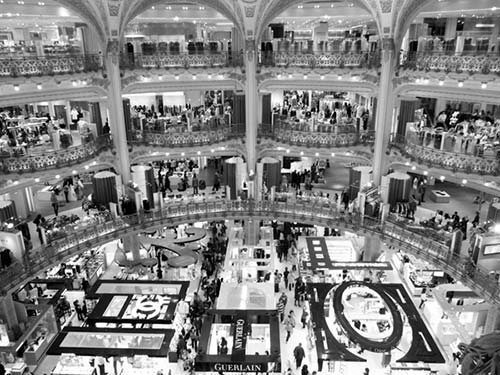
A block to the west past Galeries Lafayette Hommes (men’s) store (Mo: Havre-Caumartin), Printemps has an impressive facade that lures shoppers in search of lower prices and less glitz (think JCPenney). The store covers two buildings. The one closest to Galeries Lafayette offers a circular cafeteria (just past a distractingly Parisian lingerie department) under a massive blue glass dome on the sixth floor. The second building provides a view from its ninth-floor rooftop (ask: la terrasse?), which I find a bit better than that from Galeries Lafayette because it includes an unobstructed view of Montmartre. The rooftop comes with a breezy and reasonable bar/café with good interior and exterior seating.
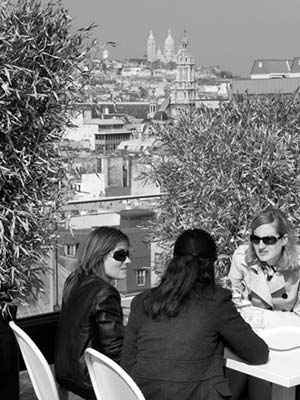
Teens and twentysomethings will flip for the Citadium mall of shops (filling a third Printemps block) on Rue Caumartin, under the skyway.
Continue your shopping by walking from this area to Place Madeleine (see “Boutique Strolls,” next).
Give yourself a vacation from sightseeing by sifting through window displays, pausing at corner cafés, and feeling the rhythm of neighborhood life. (Or have you been playing hooky and doing this already?) Though smaller shops are more intimate, sales clerks are more formal—so mind your manners. Three very different areas to lick some windows are described next: Place de la Madeleine to Place de l’Opéra, Sèvres-Babylone to St. Sulpice, and along Rue des Martyrs.
Most shops are closed on Sunday, which is a good day to head for the Marais, where many shops remain open on Sunday (and close on Saturday). For eclectic, avant-garde boutiques, peruse the artsy shops between Place des Vosges and the Pompidou Center (see map on here).
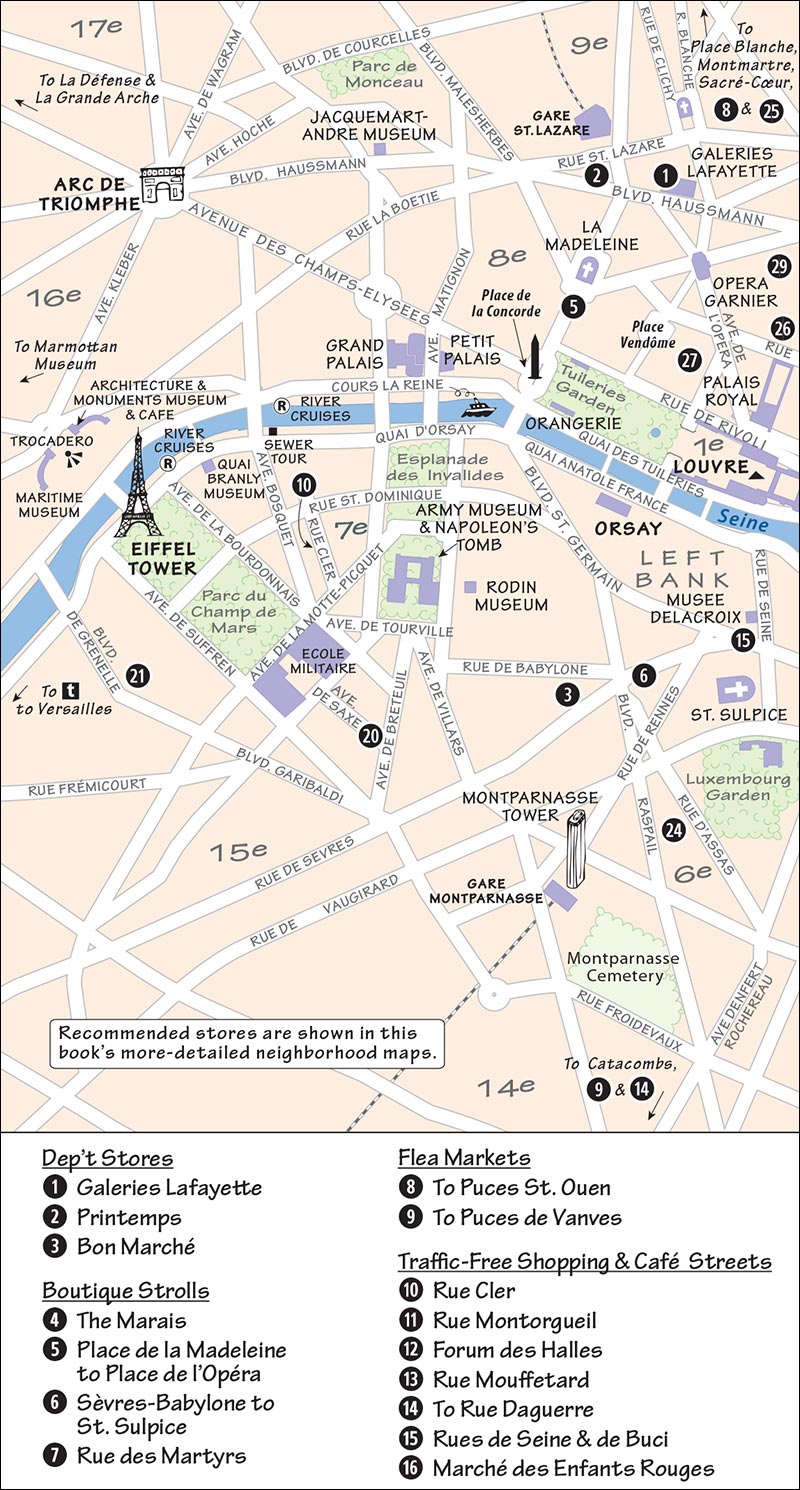
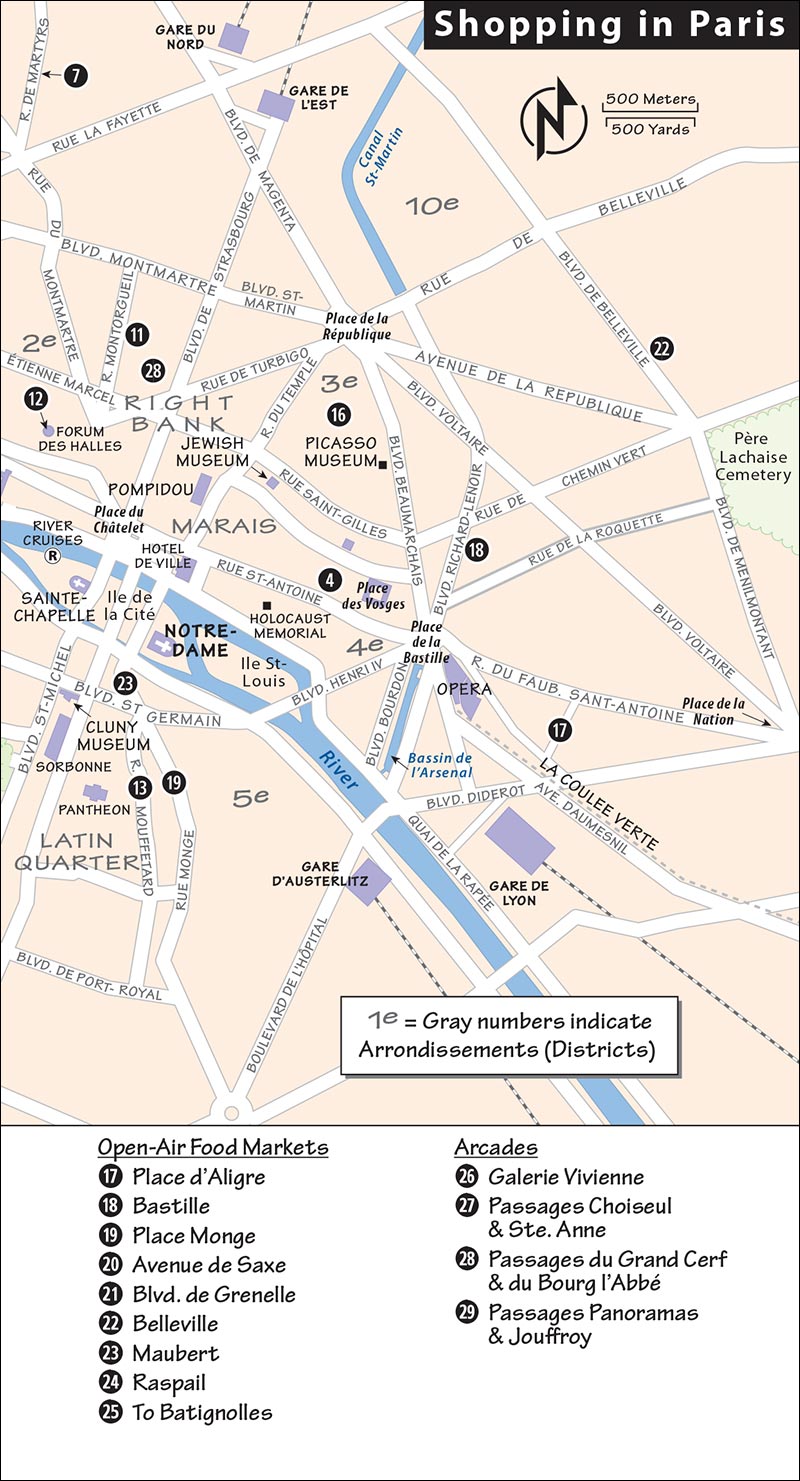

(See “Place de la Madeleine Shopping Walk” map, here.)
The ritzy streets connecting several high-priced squares—Place de la Madeleine, Place de la Concorde, Place Vendôme, and Place de l’Opéra—form a miracle mile of gourmet food shops, glittering jewelry stores, five-star hotels, exclusive clothing boutiques, and people who spend more on clothes in one day than I do in a year. This walk highlights the value Parisians place on outrageously priced products.
This walk takes about 1.5 hours (one hour if you skip the extension to Place Vendôme and Place de l’Opéra). Most stores are open Monday through Saturday from around 10:00 in the morning (or earlier) until 19:00 (or later) at night. Most close on Sunday.
• We’ll start at Eglise de la Madeleine (Mo: Madeleine). Look for Sortie Eglise de la Madeleine and start with the square’s namesake church. From there, we’ll work counterclockwise around the square. To get directly to the shopping, take Sortie Place de la Madeleine and skip to #2.
1 La Madeleine: Looking like a Roman temple with fifty-two 65-foot Corinthian columns, this church dominates the center of the square. Yes, this is a shopping stroll, and there’s nothing on sale inside, but this church is free to enter and worth a quick look (daily 9:30-19:00). Designed as a secular temple to honor Napoleon’s army, it became a church in 1842; today it’s used as both a church and concert venue.
Step through the massive bronze doors and approach the altar featuring a striking marble Mary Magdalene with three angels. The ceiling fresco celebrates great French Christians—from St. Louis (King Louis IX) to Jeanne d’Arc—in the company of Mary Magdalene and Christ in heaven above. During Chopin’s funeral, in 1849, 3,000 mourners packed this church as musicians played the famous dirge of Chopin’s Funeral March.
As you leave, appreciate the fine view down Rue Royale to the similar facade of the Assemblée Nationale (National Assembly), where the lower house of France’s parliament meets.
• OK, let’s shop. Cross the busy square and work your way left to the southeast corner (look for the black-and-white Fauchon signs). Before diving in, consider this:
The neighborhood surrounding you was originally a suburb of medieval Paris, but by the time La Madeleine was completed in the mid-1800s, it had become Paris’ most fashionable neighborhood. Glitzy belle-époque Paris revolved around this square and its surrounding streets. Today, the square is a gourmet’s fantasy, lined with Paris’ most historic and tasty food shops. Our first shop is perhaps the most famous of all.
• In the northeast corner at #24 is the black-and-white awning of...
2 Fauchon: Founded on this location in 1886, this bastion of over-the-top edibles became famous around the world, catering to the refined tastes of the rich and famous. Its tea, caviar, foie gras, and pastries set the standard for nearly a century. In the late 20th century, it faded from its glory days, closing many franchises—but recently it’s on the rebound. One sign of that rebirth is the swanky new hotel they’re building on the opposite corner of the square.

There are two Fauchon storefronts: The Traiteur-Pâtisserie at #24 has been closed for renovation but should be open by the time you visit (expect changes). This shop is like a delicatessen, with meats, meals, breads, and pastries (pâtisseries). Takeout items can cost more than many sit-down restaurant meals. Check out the various places you can buy something to eat-in: There’s the tasting bar for caviar and champagne, sidewalk seating, plus more tables (and a WC) upstairs. Or grab a stool at the boulangerie and enjoy a sponge-cake cookie: a madeleine on Place de la Madeleine (though the names are only coincidental).
Just across the street at #30 is Fauchon’s more impressive shop, the Cave, Chocolat, Epicerie. This razzle-dazzle store is all about style, branding, and packaging. Tourists gobble up anything wrapped in pink and black with Fauchon’s name emblazoned on it. Stroll upstairs to find the impressive wine and Champagne displays with €5,000 bottles of Bordeaux’s most expensive wine, Château Petrus; the magnums go for €9,000. Who buys this stuff? Good WCs hide in the basement.
• Continue your counterclockwise tour around Place de la Madeleine.
3 More Gourmet Shops: Founded in 1854, Hédiard (#21, northwest corner of the square) is older than Fauchon, and it’s weathered the tourist mobs a bit better. Wafting the aroma of tea and coffee, it showcases handsomely displayed produce and wines. Hédiard’s small red containers—of mustards, jams, coffee, candies, and tea—make great souvenirs.

Return to the square, pass by Crab Royale, then step inside tiny La Maison des Truffe (#19) to get a whiff of the product—truffles, those prized, dank, and dirty cousins of mushrooms. Check out the tiny jars in the display case. Ponder how something so ugly, smelly, and deformed can cost so much. Choose from a selection that varies from run-of-the-mill black truffles (a bargain at €50 a pound) to rare white truffles from Italy—up to €3,000 a pound. At the counter they sell every possible food that can be made with truffles, including Sauterne wine. I like the truffle brushes, and at just €22, they might be the cheapest item on this square. The shop also houses a sharp little restaurant serving truffle dishes (e.g., truffle omelet for €30, or chocolate cake with truffle ice cream for €15).
The venerable Mariage Frères (#17) shop demonstrates how good tea can smell and how beautifully it can be displayed.
• A few steps along, you’ll find...
4 Caviar Kaspia (#16): Here you can add caviar, eel, and vodka to your truffle collection. Find the price list for these cured fish eggs. The sharper-tasting Iranian caviars run €50 for a tiny-but-decorative tin. The “finer” ones, from beluga sturgeon in the Caspian Sea, sell for up to €12,500 a kilo (that’s about €5,700 a pound—think I’ll pass on that today). The restaurant upstairs serves what you see downstairs—at equally exorbitant prices. Demand for fish eggs must be strong, because a competitor (Caviar Prunier) has opened next door.
• Continue along, past Marquise de Sévígné chocolates (#11) and Fauchon’s new razzle-dazzle hotel, then cross to the island in the middle of...
5 Boulevard Malesherbes: Look to the right, down the boulevard. This kind of vista—of a grand boulevard anchored by a domed church (dedicated to St. Augustine)—is vintage Haussmann. (For more on the man who shaped modern-day Paris, see the sidebar on here.) When the street officially opened in 1863, it ushered in the Golden Age of this neighborhood.
• Continue across Boulevard Malesherbes. Straight ahead is...
6 Patrick Roger Chocolates (#3): This place is famous for its chocolates, and even more so for M. Roger’s huge, whimsical, 150-pound chocolate sculptures of animals and fanciful creatures.
• Continue on, turning right down...
7 Rue Royale: Along this broad boulevard, we trade expensive food for expensive...stuff. There’s Dior, Chanel, and Gucci. A half-block down Rue Royale, dip into the classy Village Royale shopping courtyard—an oasis of calm with its restful Le Village Café.
If you went a few hundred yards farther down Rue Royale—which we won’t on this walk—you’d reach the once-famous restaurant Maxim’s (at #3), and then spill into Place de la Concorde, with the still-famous Hôtel Crillon (see here). The US Embassy is located nearby, and this area has long been the haunt of America’s wealthy, cosmopolitan jet set.
• At Rue St. Honoré, turn left and cross Rue Royale, pausing in the middle for a great view both ways. Check out Ladurée (#16) for an out-of-this-world pastry break in the busy 19th-century tea salon, or to just pick up some world-famous macarons.
If you’ve had enough, you’re a few blocks from the Place de la Concorde Métro stop, the Tuileries Garden, and the Orangerie Museum. If you have more shopping in you, continue east down...
8 Rue St. Honoré: The street is a three-block parade of chic boutiques—L’Oréal cosmetics, Jimmy Choo shoes, Valentino, and so on. Looking for a €1,000 handbag? This is your spot. (Or, it’s a good place to ponder the fact that about half of the seven billion people living on this planet are doing it on $2 a day.) The place has long been tied to fashion. Industry titans like Hermès, Givenchy, and Lancôme were launched a few blocks west of this stretch. You’ll pass the domed Church of the Assumption, a former convent that now caters to Paris’ Polish community.
• Find the shortcut on the left at #362 or turn left on Rue de Castiglione to reach...
9 Place Vendôme: This octagonal square is très elegant—enclosed by symmetrical Mansart buildings around a 150-foot column. On the left side is the original Hôtel Ritz, opened in 1898. Since then, it’s been one of the world’s most fashionable hotels. It gives us our word “ritzy.” Hemingway liberated its bar in World War II.
The square was created by Louis XIV during the 17th century as a setting for a statue of himself (then called Place Louis le Grand). One hundred and fifty years later, Louis XIV was replaced by a towering monument to Napoleon capped by a statue of the emperor himself. That column, designed in the style of Trajan’s Column in Rome, was raised by Napoleon to commemorate his victory at the Battle of Austerlitz. The encircling bronze reliefs were made from cannons won in this and other battles. Look for images of the emperor directing battle with his distinctive hat as you scroll up the column. Elsewhere on the square, Chopin died at #12.
The square is also known for its upper-crust jewelry and designer stores—Van Cleef & Arpels, Dior, Chanel, Cartier, and others (if you have to ask how much...).
• Leave Place Vendôme by continuing straight, up Rue de la Paix—strolling by still more jewelry, high-priced watches, and crystal—and enter...
10 Place de l’Opéra: You’re in the middle of Right Bank glamour. Here you’ll find the Opéra Garnier and the Fragonard Perfume Museum (described on here). If you’re shopping ’til you’re dropping, the Galeries Lafayette and Printemps department stores (both described earlier) are located a block or two north, up Rue Halévy. If you’re exhausted from counting the zeroes on price tags, relax with a drink at venerable Café de la Paix across from the Opéra (daily, 12 Boulevard des Capucines). It’s an appropriately elegant—and pricey—way to end this tour.
• When you’re ready to go, look for the convenient Opéra Métro stop.
(See “Sevres-Babylone to St. Sulpice Walk” map, here.)
This Left Bank shopping stroll runs from the Sèvres-Babylone Métro stop to St. Sulpice Church, near Luxembourg Garden and Boulevard St. Germain, finishing near the Odéon Métro stop. You’ll sample smart clothing boutiques and clever window displays—and be tempted by tasty treats—while enjoying one of Paris’ more attractive neighborhoods. This shopping walk ties in well with my Left Bank Walk. Some stores on this walk are open Sunday afternoons, though the walk is better on other days.
Start at the Sèvres-Babylone Métro stop (take the Métro or bus #87). You’ll find the 1 Bon Marché behind a small park. The Bon Marché (means “inexpensive,” but it’s not) is Paris’ oldest department store. It opened in 1852, when fascination with iron and steel construction led to larger structures (like train stations, exhibition halls, and Eiffel Towers). The Bon Marché was the first large-scale store to offer fixed prices (no bargaining) and a vast selection of items under one glass roof, arranged in various “departments.” This rocked the commercial world and forever changed the future of shopping. High-volume sales allowed low prices and created loyal customers—can you say “Costco”? But what began as a bargain store has evolved into one of Paris’ most elegant shopping destinations.
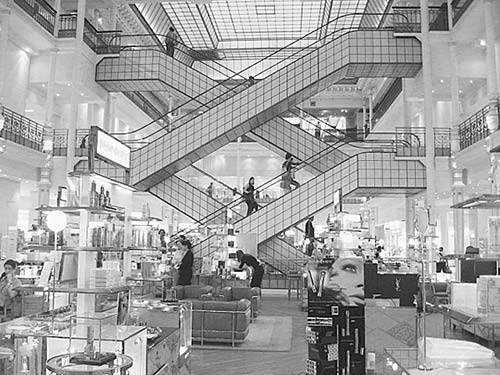
Start your tour in the center, under the atrium with a high glass ceiling and crisscross elevators. Browse the perfumes, then take the escalator up to higher floors for a better perspective. Notice the sales clerks seated behind desks rather than standing at counters (at these prices, they seem more like loan officers). Find the less glamorous escalators in the corners of the store to bring you to the very top floor, where you’ll find a treasure trove of children’s books, toys, and clothing. If you’re hungry, there are trendy restaurants in the basement and an elegant tea salon on the third floor.
From the Bon Marché, walk through the small park, cross Boulevard Raspail, and start heading down Rue de Sèvres (along the right side). The Hôtel Lutetia to your right was built for shoppers by the Bon Marché’s owners; after a lengthy floor-to-ceiling renovation, it should be open by the time of your visit. A few steps down Rue de Sèvres, you’ll find 2 La Maison du Chocolat at #19. What began in the 1970s as a boutique chocolaterie is now a worldwide chain for chocoholics. Their mouthwatering window display may draw you inside for handmade chocolates in exquisitely wrapped boxes and delicious ice-cream cones in season. Parisians commonly offer chocolates when invited over, and no gift box better impresses than one from this store.
Be sure to lick the chocolate off your fingers before entering Hermès (a few doors down, at #17), famous for its pricey silk scarves—and for the former designer of its fashion house, Jean-Paul Gaultier. Hermès’ 19th-century origin as a bridle and harness maker is reflected in its horse-and-carriage logo—and in many of its scarf designs. Don’t let the doorman intimidate you: Everyone’s welcome here. Ask to try on a scarf or two and have the salesperson teach you a few quintessential French ways to tie it. This store, opened in 2011, is housed in the original Art Deco swimming pool of Hôtel Lutetia, built in 1935. Take a spin through this ultra-trendy space, which covers more than 20,000 square feet.
Across the street sits the marvelously old-school 3 Au Sauvignon Café (10 Rue de Sèvres, open daily). It’s well situated for watching the conveyor belt of smartly coiffed shoppers glide by. Check in for a hot or cold drink, and check out the zinc bar and picture-crazy interior.
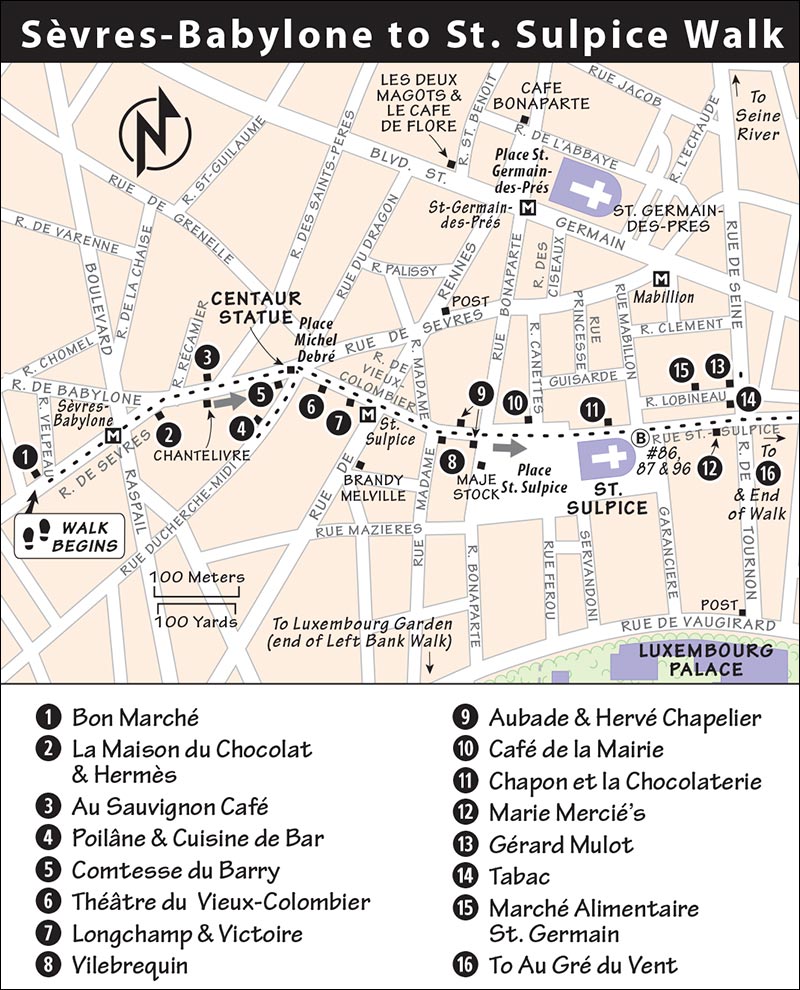
Back on the other side of the street, pop into Chantelivre (#13), France’s first bookstore specifically for young readers. This location opened in 1974 and has everything from nursery-rhyme books to educational resources to coloring books to the much beloved (by adults as wells as young ones) bandes-déssinées (comic books or graphic novels). An illustrated French children’s book is a charming souvenir for kids and a smart resource for savvy travelers wanting to learn the language.
Continue a block farther down Rue de Sèvres to Place Michel Debré, a six-way intersection. A wicked half-man, half-horse statue (ouch), the Centaur, stands guard. Designed by French sculptor César in 1985 to pay homage to his friend and mentor Pablo Picasso, it was originally intended for a more prominent square, but was installed here after many deemed it too provocative because of its metallic genitalia. The face is of the sculptor himself.
From Place Michel Debré, boutique-lined streets fan out like spokes on a wheel. Each street merits a peek if shopping matters to you.
Make a short detour up Rue du Cherche-Midi (follow the horse’s fanny). This street offers an ever-changing but always chic selection of shoe, purse, and clothing stores. Find Paris’ most celebrated bread—beautiful round loaves with designer crust—at the low-key 4 Poilâne at #8 (Mon-Sat 7:00-20:30, closed Sun). Be sure to ask: “Avez-vous une dégustation, s’il vous plaît?” (Do you have a sample please?). Parisians love getting their punitions (punishments—buttery shortbread cookies) here. Next door, the small Cuisine de Bar café is a bar à pains (bread bar) and serves open-faced sandwiches (tartines) and salads with Poilâne bread (closed Mon).
Across the way at #9, you’ll find Maje Stock, a French outlet store with prêt-à-porter (ready-to-wear) fashion a notch above mass market. “Maje” derives from the family and first names of its three sibling-founders: Milgrom, André, Judith, and Evelyn. While this neighborhood is rife with those who can afford haute-couture (custom-made high fashion), even the well-to-do appreciate a good bargain.
Return to the Centaur in Place Michel Debré. Check out the 5 Comtesse du Barry pâté store, which sells small gift packs. Then turn right and head down Rue du Vieux Colombier.
You’ll pass the 6 Théâtre du Vieux-Colombier (1913), one of three key venues for La Comédie Française, a historic state-run troupe. Enter and find the timeline to the right; take a moment to look for names you recognize. How about the playwright Anton Chekov and poet T. S. Eliot—who both wrote plays performed here—or folk singer John Denver?
In the next two blocks, you’ll pass many stores that specialize in just one or two items, but in a variety of colors and patterns. At 7 Longchamp (#21), you can hunt for a stylish French handbag in any color, and Victoire offers items for the gentleman.
Cross busy Rue de Rennes—glancing to the right at the dreadful Montparnasse Tower in the distance. If you have a teenage girl in tow, she may enjoy a short detour down Rue de Rennes to #71 and Brandy Melville (trendy and inexpensive clothes with a one-size-fits-all approach).
Others can continue down Rue du Vieux Colombier. Here you’ll find more specialty boutiques. If the man or petit-garçon in your life needs a swimsuit, check out 8 Vilebrequin (#5). There’s 9 Aubade (#4) for lingerie and Hervé Chapelier (#1) for travel totes and handbags.
Spill into Place St. Sulpice, with its big, twin-tower church. 10 Café de la Mairie is a great spot to sip a café crème, admire the lovely square, and consider your next move. Sightseers can visit St. Sulpice Church (see here) or Luxembourg Garden (here). Or you can head north on Rue Bonaparte two blocks to Boulevard St. Germain for more shopping and several grands cafés (described on here).
Our walk continues east, exiting the square (with the church on your right) along what is now called Rue St. Sulpice. 11 Chapon et la Chocolaterie (#34) is an intimate haven for chocolate lovers. Master chocolatier Patrice Chapon roasts and processes his own cocoa beans to produce the shop’s delicacies. Pause at 12 Marie Mercié’s to admire the window display of extravagant and wildly expensive hats (23 Rue St. Sulpice).
Now turn left onto Rue de Seine. What’s the best pastry shop in Paris? According to local shopkeepers, it’s 13 Gérard Mulot’s pâtisserie (closed Wed, 76 Rue de Seine). That’s saying a lot. Ogle the window display and try his chocolate macarons and savory quiches—oh, baby. Pick up lunch to go and munch it at nearby Luxembourg Garden. If you need a traditional French picnic knife to cut your quiche, backtrack to the 14 Tabac (78 Rue de Seine) for a fine selection of Opinel knives, made in Savoie since 1890. Or if you’re missing any other food supplies for the picnic, pop into 15 Marché Alimentaire St. Germain (a covered food market on the next block).
Around the corner at 10 Rue des Quatre Vents sits 16 Au Gré du Vent, a well-established consignment clothing and accessory shop, where you can rummage through the designer and even mass-market cast-offs of well-heeled neighborhood residents.
If you’d like more shopping options, you’re in the heart of boutique shopping. Sightseers could take my Left Bank Walk (you’re near several points along the route). Or catch the Métro at St. Germain, Odéon, or Mabillon to your next destination. As for me, stick a fourchette in me—I’m done.
As they race from museum to monument, visitors often miss the market streets and village-like charm that give Paris a warm and human vibrancy. Traffic-free Rue Cler is my favorite market street (see the Rue Cler Walk chapter). But for a younger and more trendy, less-touristy market ambience that still serves village Paris, stroll down Rue des Martyrs. While cars are allowed on the street, few seem to use it, making this a pleasant shopping stroll.

This walk starts at the base of Montmartre’s hill, a block from the Pigalle Métro stop, and glides downhill for six blocks, ending at the handy Métro station Notre-Dame-de-Lorette. Like any market street, it’s generally quiet on Sunday from 12:00 on, all day Monday, and the rest of the week from about 13:00 to 15:00, when shops close for a break.
From the Pigalle Métro stop, head east a short distance along Boulevard de Clichy to the first street and turn right on Rue des Martyrs, passing a Carrefour supermarket. Peaceful and sophisticated, Rue des Martyrs makes a stark contrast with the Montmartre scrum; here you’ll enter a finer neighborhood with broader streets, richer buildings...and signs of the reality of raising a family in an urban setting.
Security can be a concern. The school immediately on your right has barriers to keep possible car bombs at a distance. Several side streets are “voie privée”—private lanes or high-rise, gated communities. Behind big carriage doors, lanes lead to peaceful inner courtyards serving clusters of apartments. The carousel at the intersection is a reminder that families here live in tight quarters. Along with small children, they have small merry-go-rounds, small kitchens, tiny fridges, and minuscule cars. They shop daily for small amounts—which helps keep the neighborhood strong.
Slalom past people strolling with dogs and babies. Notice the variety of small shops. Goods spill out onto the sidewalk. People know their butcher and baker as if they lived in a village (in their opinion, they do). Locals willingly pay more in a shop that’s not part of a chain, and le fast food is not cool.
Paris is one of the most densely populated cities in Europe, which makes the streets particularly vibrant. Look up and imagine how population density is great news for fishmongers, flower merchants, and bakers. In some areas, fishmongers and butchers are being replaced with Wi-Fi coffee shops and trendy deli-type restaurants, though a good bakery still seems in demand.
At #58, find one of Paris’ countless late-night grocery stores. These are generally run by North African immigrants who are willing to work the night shift for the convenience of others. Beware: Produce with the highest prices is often priced by the half-kilo.
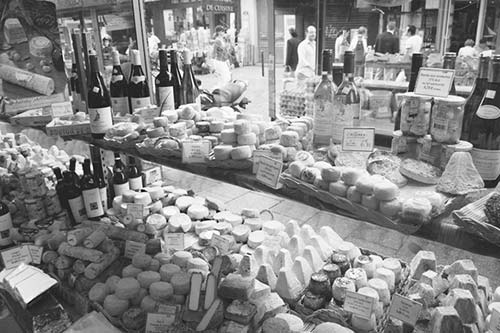
At #50, the cheesemonger has been serving the neighborhood ever since it actually had goats and cows grazing out back. Notice the marble shelves, old milk jugs, and small artisanal cheeses.
At #46, the English-owned Rose Bakery serves a young, affluent, and health-conscious crowd with top-quality organic and vegetarian breakfasts and lunches. The selection of mouth-watering foods at their takeout shop next door merits a look. Across the street, the baker Delmontel (at #39) proudly displays his “best baguette in Paris” award from 2007 and his fresh-baked temptations. At #42 sits Terra Corsa, a café/gourmet food shop selling fine foods from Corsica and tasty lunch plates served with wine, beer, or Corsican cola. Maison Landemaine (at #26) is another eye-popping bakery.
Continuing your stroll on Rue des Martyrs, passing the traditional butcher at #21. You know he’s good because the ceiling hooks—where butchers once hung sides of beef—now display a red medallion that certifies the slaughtered cow’s quality. Just as carrots come with greenery intact for the discerning shopper, here the chicken comes with its head on, the rabbit with his heart exposed, and the fish with eyes open. Freshness is expected.
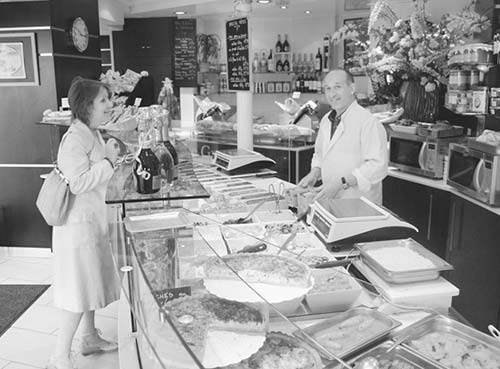
Sebastian Gaudard’s pâtisserie at #22 is worth popping in to see the typically French edible works of art. Bakers enjoy making special treats in sync with the season: Easter, Christmas, First Communion, and so on.
Nearby, at #20, the tabac/café copes with the smoking ban by putting out heaters (in cool weather) and as many tables as will fit on the sidewalk. Shops like this—once run by rural people from what was then France’s poorest region, Auvergne—are now often managed by Chinese immigrants. Traditionally the corner café was the community’s utility sales outlet—where you could pay parking tickets, pick up stamps and Métro tickets, and play the lottery. Despite the giant letters reading “fumer tue,” (smoking kills) cigarettes sell well. Oh...and there’s good coffee, too.
Down the street (at #9) sit two ultra-specialized food shops: one selling olive oils made exclusively from French olives and La Chambre à Confiture, displaying fruity creations like fine jewels that will forever change the way you think of jam (they’re generous with samples).
The “City” Carrefour at #7 is a small version of a big supermarket chain. With long hours daily and more convenience, modern supermarkets are threatening many smaller shops. Across from Carrefour, browse the long line of produce. Note how price tags come with the place each item was grown. Two more butchers and a cheese shop later, you reach the neighborhood church (the Neoclassical Notre-Dame-de-Lorette, circa 1836) and the end of this street.
Our walk is over. The Métro station Notre-Dame-de-Lorette (line 12) awaits. Find the discreet entrance on the opposite (front) side of the church.
Paris’ sprawling flea markets (marché aux puces; mar-shay oh-pews; puce is French for “flea”) started in the Middle Ages, when middlemen sold old, flea-infested clothes and discarded possessions of the wealthy at bargain prices to eager peasants, allowing buyers to rummage through piles of aristocratic garbage.
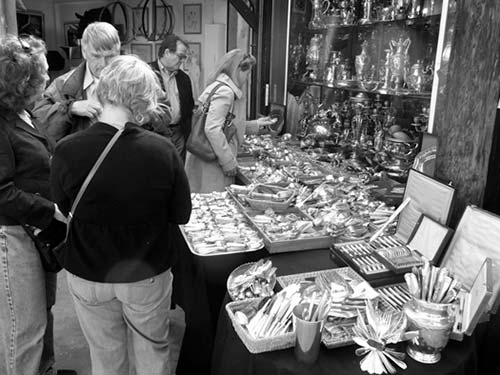
(See “Puces St. Ouen Flea Market” map, here.)
Puces St. Ouen (pews sant-oo-an), at Porte de Clignancourt, carries on the Parisian flea market tradition, but at a more elevated level—the fleas are gone, as are the bargain prices. This is the mother of all flea markets, a sprawling complex of covered market halls and vendor-friendly streets, attracting interior designers and those who appreciate this ever-changing museum of household goods. More than 2,000 vendors sell everything from flamingos to faucets, but mostly intriguing antiques and vintage silver and art (Sat 9:00-18:00, Sun 10:00-18:00, Mon 11:00-17:00, closed Tue-Fri, pretty dead the first 2 weeks of Aug, tel. 01 58 61 22 90, www.les-puces.com). There’s a TI dead center in the market at 120 Rue des Rosiers.
Getting to Puces St. Ouen: Take Métro line 4 to the end of the line at Porte de Clignancourt, then carefully follow Sortie, Marché aux Puces signs and walk straight out of the Métro down Avenue de la Porte de Clignancourt toward the white overpass (should you exit at a different Sortie, cross the big square with your back to the lone red-brick building to find Avenue de la Porte de Clignancourt). Approaching the flea market, you’ll pass blocks of tents hawking trinkets and cheap clothing. Ignore street vendors selling knockoff designer bags, watches, fake Marlboro cigarettes, and more. Your destination is just beyond the elevated freeway. Cross under the freeway—leaving Paris and entering the suburb of St. Ouen—and turn left on Rue des Rosiers, the spine that links the many markets of St. Ouen (see map).
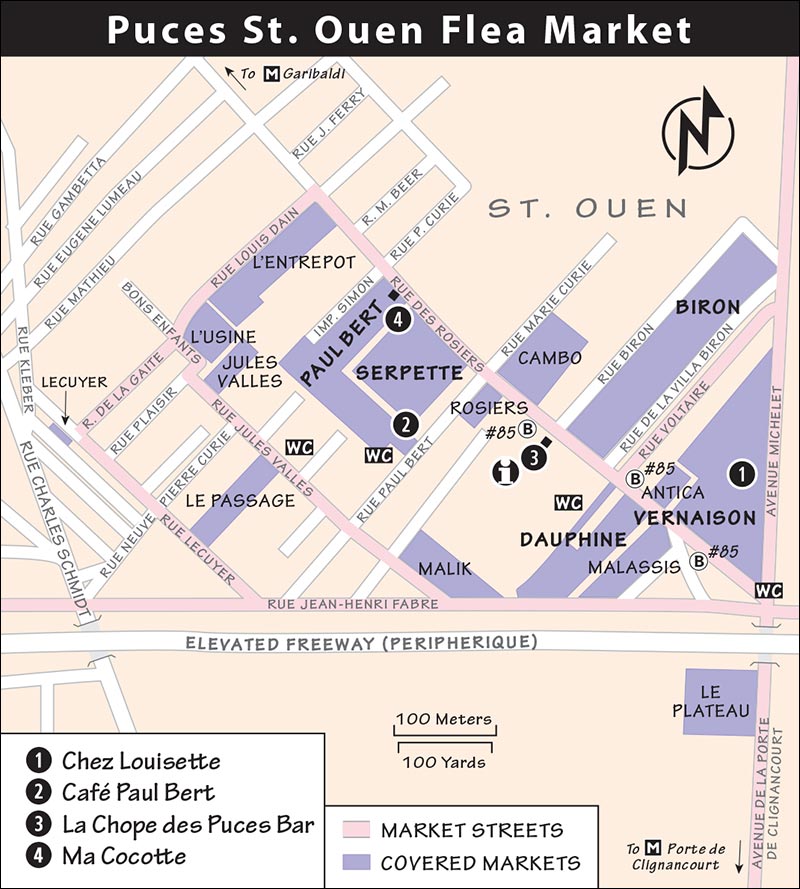
Bus #85 runs (slowly) from central Paris right into the St. Ouen market along Rue des Rosiers, letting you skip the scruffy stretch between the Métro station and the market. Catch it (direction: Mairie de St-Ouen) from stops located near the Luxembourg Garden, Hôtel de Ville, or Montmartre. To return to the city, navigate back to Rue des Rosiers and hop on buses heading to Luxembourg.
Visiting the Market: The St. Ouen “market” is actually a well-organized collection of five markets, each with a different name and specializing in a particular angle on antiques, bric-a-brac, and junk. The markets feel quite safe and calm; they get downright peaceful the farther in you venture. You can bargain a bit (best deals are made with cash at the end of the day), though don’t expect swinging deals here.
The area just outside the market complex shows off Paris’ gritty, suburban underbelly (in Paris, the have-nots live in the burbs, while the haves want to be as central as they can get). No event brings together the melting-pot population of Paris better than this carnival-like market. Some find it claustrophobic and unsettling; others find French diamants-in-the-rough and return happy. (Wear your money belt; pickpockets and scam artists thrive in these wall-to-wall-shopper events). Avoid the crowds along Avenue Jean-Henri Fabre, parallel to the freeway, and you’ll do fine.
Space for this flea market was created in the 1800s, when the city wall was demolished (its path is now a freeway), leaving large tracts of land open. Eventually the vacuum was filled by street vendors, then antique dealers. The hodgepodge pattern of the market reflects its unplanned evolution. Strolling the stalls can feel more like touring a souk in North Africa—a place of narrow alleys packed with people and too much to see.
Explore the markets of Puces St. Ouen by walking down the “spine” of the market area, Rue des Rosiers—look for a map that tries to explain the general character of each (get it at shops or the TI branch at 120 Rue des Rosiers). Here’s a brief rundown of the markets accessed from Rue des Rosiers: Vernaison is mostly small shops selling a mishmash of stuff from lace doilies to clock parts to coffee tables. Dauphine is a glass-roofed arcade with quiet, mostly eclectic furniture shops lining its interior-only lanes; you’ll find antique clothing upstairs. Biron and Serpette have classy antiques, and Paul Bert features open lanes of shops selling high-end designs for your home, with clean—and free—WCs.
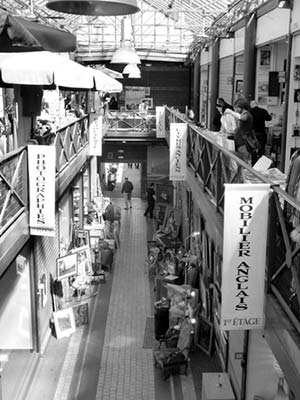
Even if antiques, African objects, and T-shirts aren’t your thing, you may still find this market worth the trip. Pretend you just rented a big, empty apartment...and need to furnish it. Come for a reality check—away from the beautiful people and glorious monuments of Paris—and get a dose of life in the ’burbs. If you’re considering buying a large item, be aware that shipping is very expensive (the Camard company has the best reputation, tel. 01 49 46 10 82, www.antikaparis.com/camard).
Eating at Puces St. Ouen: Time your trip around lunch; there are many lively and reasonable cafés. Buried in Vernaison Market, $$ Chez Louisette delivers a rousing lunch experience. Listen to a latter-day Edith Piaf and enjoy an average-quality meal with a Toulouse-Lautrec look-alike. Madame belts out vintage French chansons with an accordion and keyboard to back her up, the ramshackle decor is laced with hanging garlands and big chandeliers, and the jovial crowd sings along. It’s popular, so come right at noon or expect to wait (expect to tip the singers, Sat-Mon only, 130 Avenue Michelet, tel. 01 40 12 10 14). $$ La Chope des Puces bar has a down-and-dirty, très local feel and is famous for its live Gypsy music concerts on Saturday and Sunday afternoons (open 10:30-19:00, next to the TI at 122 Rue des Rosiers, tel. 01 40 11 28 80). $$ Café Paul Bert is where locals come for a traditional brasserie meal and owns the best outside seating. The decor is wonderful, and the cuisine wins rave reviews (lunch only, closed Tue-Wed, in the heart of the Paul Bert Market at 20 Rue Paul Bert, tel. 01 40 11 90 28). High-end interior designers and costume makers flock to $$$ Ma Cocotte. This upscale bistro was designed by living legend Philippe Starck and is tucked into the Paul Bert Market just off Rue des Rosiers (open daily, 106 Rue des Rosiers, tel. 01 49 51 70 00).
Comparatively tiny and civilized with sidewalk stalls and a more traditional flea-market feel, Puces de Vanves is preferred by many market connoisseurs (Sat-Sun 7:00-14:00, best to arrive before 13:00—when the best stalls close, closed Mon-Fri, Mo: Porte de Vanves).
Several traffic-free street markets overflow with flowers, produce, fish vendors, and butchers, illustrating how most Parisians shopped before there were supermarkets and department stores. Shops are open daily except Sunday afternoons, Monday, and lunchtime throughout the week (13:00 to 15:00 or 16:00). Browse these markets for picnics, or find a corner café from which to appreciate the scene.
Rue Cler—a wonderful place to sleep and dine as well as shop—is like a refined street market, serving an upscale neighborhood near the Eiffel Tower (Mo: Ecole Militaire; for details, see the Rue Cler Walk chapter and the Sleeping in Paris and Eating in Paris chapters).
Rue Montorgueil and Rue Montmartre are thriving and locally popular café-lined streets that run parallel just north of Les Halles. Several traffic-free lanes cross these streets, creating a delightful area for pedestrians. Ten blocks from the Louvre and five blocks from the Pompidou Center, Rue Montorgueil (mohn-tor-goy) is famous as the last vestige of the once-massive Les Halles market (just north of St. Eustache Church, Mo: Etienne Marcel). Once the home of big warehouses and wholesale places to support the market, these have morphed into retail outlets to survive. Today you’ll find cafés and cute bistros. Among the few food shops are, most importantly, the irresistible creations at Pâtissier Stohrer, where the French expression for “window licking” must have started (51 Rue Montorgueil, tel. 01 42 33 38 20). Don’t miss the nearby covered arcade, Passage du Grand Cerf, described later. Rues Montorgueil and Montmartre lead directly to the Forum des Halles, a huge modern shopping mall under a vast, yellow, eye-catching (and water-catching) glass-and-steel canopy; see here for more information.
Rue Mouffetard, originally built by the Romans, is a happening market street by day and does double-duty as restaurant row at night (see here). Hiding several blocks behind the Panthéon, it starts at Place Contrescarpe and ends below at St. Médard Church (Mo: Censier Daubenton). The upper stretch is pedestrian and touristic; the bottom stretch is purely Parisian. Pause for a drink on picturesque Place Contrescarpe, then make your descent down this popular street.
Rue Daguerre, near the Catacombs and off Avenue du Général Leclerc, is the least touristy of the street markets listed here, mixing food shops with cafés along a traffic-free street (Mo: Denfert-Rochereau; for Catacombs description, see here).
Rue de Seine and Rue de Buci combine to make a central, lively, and colorful market within easy reach of many sights (Mo: Odéon; see also “Les Grands Cafés de Paris,” on here, and my Left Bank Walk). This is a fine place to enjoy a late afternoon drink and observe Parisian shoppers at work (also fun for dinner and late-night café action).
Rue des Martyrs, near Montmartre, makes Paris feel like a village. Consider exploring this lively (though not traffic-free) market scene as part of my Rue des Martyrs boutique stroll, earlier.
Marché des Enfants Rouges is a compact, covered market for the northern Marais neighborhood. It’s also the oldest covered food market in Paris, built when Louis XIII ruled in 1615. It’s named for an orphanage where the children wore red uniforms (the name means “Market of the Red Children”). Here you’ll find everything under one roof: organic produce; stands offering wine tastings; fun, cheap, international lunch options—and scads of character (Tue-Sat 8:30-20:00, until 18:00 in winter, produce stands closed 13:00-15:00; Sun 9:00-14:00, closed Mon; a 15-minute walk north from the heart of the Marais at 39 Rue de Bretagne, Mo: Filles du Calvaire or Temple, see the East Paris color map at the front of this book). Find the man making socca—a chickpea-flour crêpe specialty from Nice, and consider lunch at any of the food stands.
Every neighborhood has a marché volant (“flying market”), where piles of food stalls take over selected boulevards and squares throughout Paris for one to three mornings each week (for a complete list, visit www.goparis.about.com and search for “food markets”). Expect a lively combination of flea- and street-market atmosphere and items.
Marché d’Aligre, 10 blocks behind the Opéra Bastille down Rue de Faubourg St. Antoine, is a small open-air market where you’ll encounter few tourists. You’ll find lots of fresh produce, a small but atmospheric market hall, and a swap-meet-like square for trinket shopping (Tue-Sun 9:00-13:30, closed Mon, Place d’Aligre, Mo: Ledru-Rollin). From Métro Ledru-Rollin, walk east (with your back to the Bastille column) and veer right at the second traffic light onto Rue Crozatier.
Marché de la Bastille is the best of the lot, with a vast selection of products extending more than a half-mile north of Place de la Bastille along Boulevard Richard Lenoir (Thu and Sun until 14:30, Mo: Bastille); consider combining either of these two markets with a stroll through La Coulée Verte park (see here) and my Marais Walk.
Marché Place Monge is small, with produce, clothing, and a few crafts (Wed, Fri, and Sun 8:00-13:00; near Rue Mouffetard, Mo: Monge).
Marché de Saxe, near the Eiffel Tower, is a thriving street market that runs along Avenue de Saxe from behind the Ecole Militaire building to Place de Breteuil (Tue, Thu, and Sat until 15:00).
Marché Boulevard de Grenelle, a few blocks southwest of Champ de Mars park and the Rue Cler area, is packed with produce, nonperishable goods, and Parisians in search of a good value (Wed and Sun 7:00-12:30, between Dupleix and La Motte Picquet-Grenelle Métro stops).
Marché Belleville is big, favored by locals, and very untouristy (Tue and Fri, Mo: Belleville).
Marché Maubert, in the Latin Quarter, is a handy market for those sleeping in the Luxembourg Garden and Ile St. Louis neighborhoods (Tue and Thu 7:00-14:30, on Boulevard St. Germain and Place Maubert, Mo: Maubert Mutualité).
Marché Raspail, between Rue du Cherche-Midi and Rue de Rennes, is where the rich and famous shop for organic and high-end foods (Sun 9:00-15:00, Mo: Rennes).
Marché des Batignolles is Paris’ largest organic market, located along Boulevard des Batignolles between Métro stations Place de Clichy and Rome (Sat 8:30-20:00, Sun 8:30-14:00). Saturdays are also big wedding days in Paris: Sneak up Rue des Batignolles to the neighborhood Hôtel de Ville (16 Rue des Batignolles), have a post-market coffee in a café across the street, and watch as the colorful wedding parties stream by.
More than 200 of these covered shopping streets once crisscrossed Paris, providing much-needed shelter from the rain. The first were built during the American Revolution, though the ones you’ll see date from the 1800s. Today only a handful remain to remind us where shopping malls got their inspiration, although they now sell things you would be more likely to find in flea markets than at Macy’s. Here’s a short list to weave into your sightseeing plan. (They’re found on the map in this chapter and on the East Paris color map at the front of this book.)
Galerie Vivienne, behind the Palais Royal off Rue des Petits-Champs and a few blocks from the Louvre (ideal to combine with a visit to the courtyards of Palais Royal), is the most refined and accessible of the passages (Mo: Pyramides, Bourse, or Palais Royal). Inside this classy arcade, you’ll find a chic wine bar (Legrand Filles et Fils, tel. 01 42 60 07 12), tea salon, funky café, and trendy dress shops.
Passage Choiseul and Passage Ste. Anne, four blocks west of Galerie Vivienne, are fine examples of most Parisian passages, selling used books, paper products, trinkets, and snacks (down Rue des Petits-Champs toward Avenue de l’Opéra, same Métro stops).
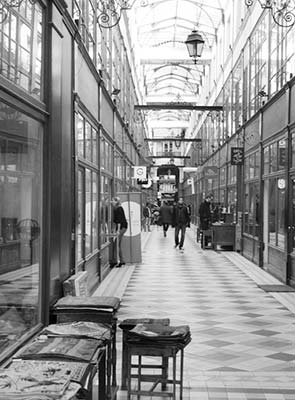
Passage du Grand Cerf and Passage du Bourg l’Abbé, near Les Halles (just off Rue St. Denis) are two elegant arcades separated by Rue St. Denis. They feature small offices, artsy galleries, fabric shops, and paint stores. Savor a drink at the atmospheric Café le Pas Sage with views into the Passage du Grand Cerf. These passages are easily combined with a visit to the nearby Rue Montorgueil street market described earlier (a block from Rue Montorgueil up Rue Marie Stuart, Mo: Etienne Marcel).
Passage Panoramas and Passage Jouffroy are long galleries that connect with several other smaller passages to give you the best sense of the elaborate network of arcades that once existed (on both sides of Boulevard Montmartre, between Métro stops Grands Boulevards and Richelieu Drouot).